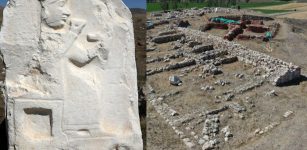Florentine Codex: Remarkable Manuscripts About Life Of The Aztecs
A. Sutherland – MessageToEagle.com – The Florentine Codex is an ancient document that describes the life of the Aztecs, their religious ceremonies, astronomy, economy, social order, the conquest of Mexico and customs in pre-Columbian Mexico.

It consists of 12 volumes prepared by Franciscan Friar Bernardino de Sahagún (1499 -1590), or under his supervision between 1540 and 1585. The Codex has 1,200 pages and 2,468 painted illustrations. Text the language of the Aztecs, Nahuatl, is located on the right side, and the Spanish translation of the left side of the manuscript.
The document was written in the language of the Aztecs, Nahuatl, the Latin and Castilian, but many paragraphs have never been translated.

The Florentine Codex has 12 sections on subjects such as the gods and ceremonies; creation, soothsayers, omens, prayers and theology, the Sun, Moon, and stars and the calendar, kings and lords, merchants, peoples, earthly things (animals, plants, metals, stones, colors), and the conquest of Mexico.
The Codex describes Nahua tactics of warfare, Aztec history, major gods, calendar, social structure and stratification, and perceptions of the natural world are some of the subjects.
The Codex (held in the Laurentian Library of Florence, Italy) is a copy of a lost original that originates from the sixteenth century; it was entitled “Universal History of the Things of New Spain” (La Historia Universal de las Cosas de Nueva España) but today, it is commonly known as “The Florentine Codex”.

It is believed that the manuscript was modeled on older manuscripts coming from about 1500 AD and based on historical records of conversations and interviews that the monk conducted among local chiefs and the Aztec people – who clearly remembered the days before the Spanish Conquistadors had arrived and lived in Tenochtitlan and its twin city Tlatelolco, and Texcoco.
Historians believe that Friar Sahagún created several shortened versions of his work. One of these versions is, for example, devoted to the history of the Aztec gods and according to sources, it was sent by Sahagún to Pope Pius V (1504 – 1572), a professor of philosophy and theology for years and grand inquisitor of the Roman church.
The complete version of the Florentine Codex (Code of Florence) was published in 1979.
Written by – A. Sutherland – MessageToEagle.com Senior Staff Writer
Copyright © MessageToeagle.com All rights reserved. This material may not be published, broadcast, rewritten or redistributed in whole or part without the express written permission of MessageToeagle.com
Expand for referencesReferences:
Kerpel Magaloni, The Colors of the New World: Artists, Materials, and the Creation of the Florentine Codex
Related Posts
-
 Ancient Petroglyphs Of Cholpon-Ata And Mysterious Balbals Figures That Guard Grave Sites, Kyrgyzstan
No Comments | Aug 18, 2015
Ancient Petroglyphs Of Cholpon-Ata And Mysterious Balbals Figures That Guard Grave Sites, Kyrgyzstan
No Comments | Aug 18, 2015 -
 The Vinland Map Is A Fake – New Evidence Uncovered By Scientists
No Comments | Sep 21, 2021
The Vinland Map Is A Fake – New Evidence Uncovered By Scientists
No Comments | Sep 21, 2021 -
 Why Is Rome Called ‘The Eternal City’?
No Comments | Jul 20, 2024
Why Is Rome Called ‘The Eternal City’?
No Comments | Jul 20, 2024 -
 Gargoyles – Mysterious Ancient Fearsome Creatures Warding Off Evil
No Comments | Dec 19, 2015
Gargoyles – Mysterious Ancient Fearsome Creatures Warding Off Evil
No Comments | Dec 19, 2015 -
 Spectacular Vardzia Cave Monastery – Huge Underground Complex Founded By The “Mountain Queen” Tamar
No Comments | Dec 28, 2015
Spectacular Vardzia Cave Monastery – Huge Underground Complex Founded By The “Mountain Queen” Tamar
No Comments | Dec 28, 2015 -
 Ancient Hittite Temple Dedicated To The Goddess Of Night To Be Unearthed
No Comments | Oct 2, 2021
Ancient Hittite Temple Dedicated To The Goddess Of Night To Be Unearthed
No Comments | Oct 2, 2021 -
 Unraveling The Secret History Of King Arthur And Robin Hood
No Comments | Jul 1, 2015
Unraveling The Secret History Of King Arthur And Robin Hood
No Comments | Jul 1, 2015 -
 Celts In Poland: Iron Smelting Furnaces Used By Celts 2,400 Years Ago – Unearthed
No Comments | Dec 1, 2019
Celts In Poland: Iron Smelting Furnaces Used By Celts 2,400 Years Ago – Unearthed
No Comments | Dec 1, 2019 -
 Ancient Human Feeding Behavior Studied By Scientists
No Comments | Jan 20, 2022
Ancient Human Feeding Behavior Studied By Scientists
No Comments | Jan 20, 2022 -
 Why Were Uncomfortable Poulaines High Fashion During The Middle Ages?
No Comments | May 18, 2024
Why Were Uncomfortable Poulaines High Fashion During The Middle Ages?
No Comments | May 18, 2024
